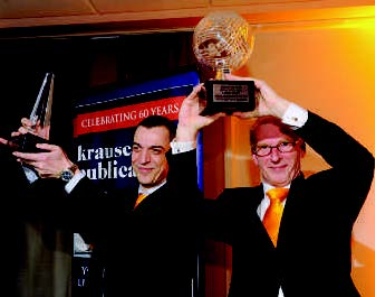March 12, 2013 – The Royal Dutch Mint (RDM) has won the ‘2012 Coin of the Year Award’ for its Mint Building Centenary 5 euro coin, which was presented at the World Money Fair in Berlin.
RDM designer Juan José Sánchez Castaño (left) and Maarten Brouwer (right) at the Coin of the Year award ceremony in Berlin. Source: Currency News.
The coin was designed in-house by Juan José Sánchez Castaño of the RDM and created using the company’s proprietary laser engraving technology and security design software from Jura.
In 2006, the RDM took the decision to go ‘digital’ – moving from mechanical to laser engraving to generate its coin dies. To do so, it acquired a 50% stake in the Dutch company Lasertec BV, the two sharing the costs of technical development. In 2008 the first dies were produced, and the RDM moved shortly thereafter from laboratory to production. The equipment was recently upgraded with a laser diode, and the next commemorative coin will be the result.
The Mint Building Centenary coin celebrates the 100th anniversary of the facility which houses the RDM, and architectural features of the facade of this neo-renaissance structure have been used in the design, notably on the front of the coin.
Several of the design features in the coin were made possible only through RDM’s laser technology. One of the techniques – Minted Security Printing (MSP) – generates a series of engraved lines of differing widths and depths that, as its name implies, recreates the fine line detail characteristic of banknotes. It was used, for example, to create the variable image in the rectangle on the reverse of the coin.
Another patented technique demonstrated in the coin is MultiView Minting (MVM), whereby multiple images can be applied to a small surface on the coin, becoming visible or invisible depending on the viewing angle. In the coin, this is shown below the portrait, and has six different visual effects according to the viewing angle.
The portrait of Queen Beatrix of the Netherlands (who is soon to abdicate) was created with a separate technique known as Minted Photo Image (MPI) – comprising a series of engraved dots of differing widths and depths that create an image of nearphotographic quality.
A variation of this was used for the QR code on the reverse of the coin (which links to a special internet page containing additional information on the coin). This is the first time such a code has been incorporated into a coin and was created through a pattern of concave dots. When these are placed close enough together, they create the black areas that make up the code, which can be picked up with smartphones.
MSP technology is commonly used on the circulating coins the RDM designs for its customers. The MVM and MPI techniques have been used on commemorative coins for Luxembourg and the Rome Treaty commemorative coin.
The Coin of the Year awards are run by Krause Publications and comprise ten different categories. The RDM was the winner of the innovation category (announced in December), as well as the overall award. 99 coins issued by mints and national banks around the world were nominated.
This article has been taken from the February issue of ‘Currency news’.
This is the website of the Royal Dutch Mint.
The Royal Dutch Mint presented its new technologies during the Technical Forum in Berlin. You can read an extensive article on this event here.





